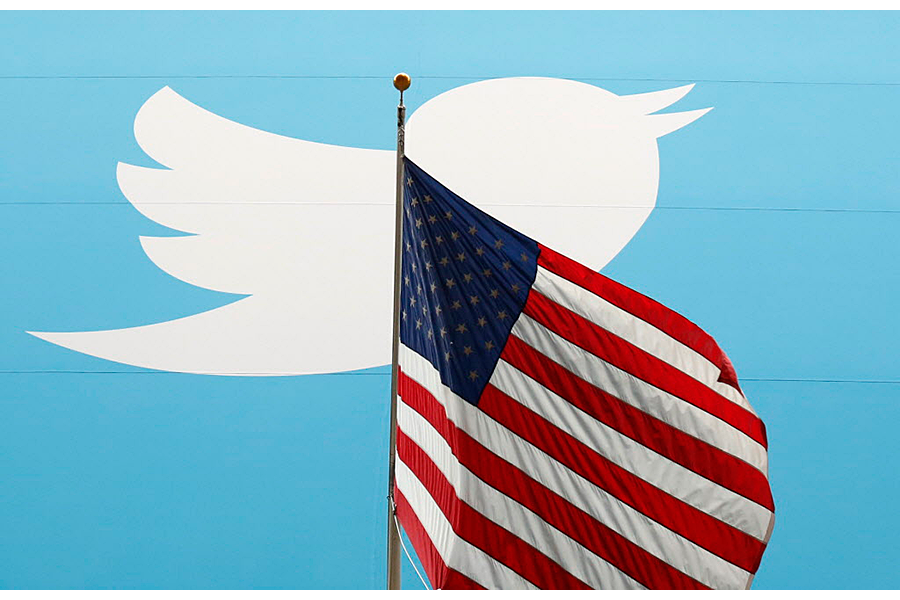On Election Day, the winner is – Twitter?
Loading...
Election Day was Twitter’s once again on Tuesday, as the social media service saw a record number of tweets posted to its platform throughout the day.
“For all of its flaws and the badness of the product itself, the election has proven Twitter is vital,” Ben Thompson, the founder of Stratechery, a technology industry analysis site, told The New York Times. “The immediacy and speed is unmatched by any other network.”
Twitter’s surging popularity contrasts with its recent dive in stock value, an unsuccessful attempt to sell itself off, and its announcement it would cut 9 percent of its workforce and close the video app Vine. From the first presidential debate in September to the hours after the polls closed, however, more than one billion election-related posts swirled across the network.
While detractors have criticized Twitter for the hateful, misogynistic, and anti-Semitic tweets that have gone unchecked on its network, its popularity on Election Day has once again shown that its real-time flow of information and discussions is indispensable in the new media age.
This was evident in the number of tweets posted on the site starting early Tuesday. By 11 a.m. EST, 27,000 election-related posts circulated across the network every minute, according to The New York Times. By 10 p.m., the total number jumped to about 40 million, exceeding the 31 million sent on Election Day 2012.
This success started with Twitter’s early effort to prepare for the big day. In addition to ramping up its ad sale operations, it streamed video on its platform, starting with the Democratic and Republican National Conventions. For Election Day, Twitter partnered with BuzzFeed to broadcast the news site's election coverage from its offices in New York City. A number of websites also embedded tweets onto their web pages, from news sites such as The New York Times and The Washington Post to entertainment-focused sites such as TMZ and Perez Hilton.
But the appeal of Twitter on Election Day is likely bolstered by how Americans follow the presidential race, as USA Today’s Jessica Guynn wrote.
“Social media is a popular destination for American voters on election night. They fire up laptops, tablets and smartphones – and sometimes all three – to spend the evening in the company of election-obsessed friends and followers around the country,” she writes. “Facebook is the spot where many people seek support and camaraderie from friends. But Twitter is frequently the spot where people hunt for the latest information and commentary.”
Republican presidential candidate Donald Trump has also brought newfound attention to Twitter, championing it as a “modern-day form of communication.” Throughout the election, he fired off Twitter posts at odd hours of the morning, and the picture he sent of himself eyeing his wife's ballot as they voted went viral Tuesday. The New York Times even reported this past week that Mr. Trump’s campaign had wrested his Twitter account away from him in an effort to control his temper and his loose hands. But some of Trump’s supporters and members of the alt-right have stirred controversy this election.
Twitter has been criticized for its inability to check posts many consider hateful, misogynistic, and anti-Semitic. According to the Anti-Defamation League, Twitter experienced an uptick between August 2015 and this past July in the number of anti-Semitic tweets directed at journalists, with at least 800 journalists receiving such messages. George Washington University’s Program on Extremism also recently found white nationalists and Nazi sympathizers have run largely unchecked on Twitter, as their followings have grown.
In response to recent criticism about the spread of hateful messages on its platform, Twitter pointed to its get-out-the-vote initiatives.
“Our goal is to increase engagement in the election process and encourage voter turnout,” a Twitter spokesman said in a statement.
With 317 million monthly users (Facebook has 1.79 billion monthly active users), Twitter has shown there’s still a place for it in the social media world.
“The core ideals that made the product great are not lost, yet, even if they’ve been obscured,” tech journalist Joshua Topolsky wrote in a New Yorker piece early this year. “The directness and power at the heart of Twitter – short bursts of information that can make you feel that you’re plugged into a hulking hive mind – are still its greatest asset.”







